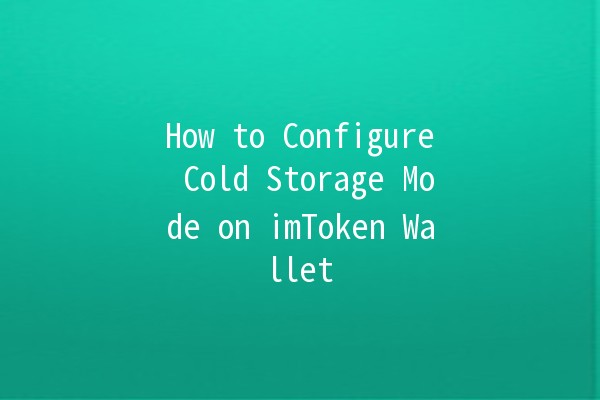Setting up your cryptocurrency assets securely is an essential aspect of managing your investments. One effective way to enhance the security of your digital assets is by using a cold wallet storage mode with the imToken wallet. This article will guide you through the process of configuring cold storage on imToken, providing actionable tips and insights for maximizing your asset protection. Additionally, we will cover key techniques to enhance your productivity while managing your cryptocurrency storage efficiently.
Cold wallets, unlike hot wallets, are not connected to the internet, making them far less vulnerable to hacking and malware. By utilizing cold storage for your cryptocurrency, you significantly reduce the risk of losing your assets due to cyberattacks. In this section, we will explore the necessity of cold wallets and the unique advantages they offer.

To set up cold storage on imToken, you’ll need to follow a few essential steps. Below we break down the process into manageable parts.
Begin by downloading the imToken wallet from their official website. It is available on both iOS and Android devices. Ensure that you download the latest version to benefit from the most recent security features.
Now that you have your wallet set up, let’s configure the cold storage.
To transfer your cryptocurrency assets to your cold wallet, follow these steps:
To secure your cold wallet further, consider keeping it offline most of the time:
Use a secure USB drive or hardware wallet to store your private keys.
Only connect to the internet when you need to make a transaction.
Managing a cold wallet might seem timeconsuming at first, but with the right techniques, you can significantly increase your productivity while minimizing risks.
Plan specific intervals (e.g., weekly or monthly) to review your asset distribution and security settings. This structured approach ensures you stay updated without feeling overwhelmed.
Implementation Example: Create calendar reminders for your checkin days. During these times, you'd verify all your assets, crosscheck your security settings, and update passwords if necessary.
By utilizing wallet aggregators, you can efficiently manage multiple wallets in a single interface. This helps save time and reduces the chances of overlooking secure storage.
Implementation Example: Consider using platforms like DeFi wallets that support various assets. Make it a habit to consolidate information before making significant decisions.
Setting up automated alerts for significant market movements can help reduce manual monitoring. This keeps you informed without the constant attention required otherwise.
Implementation Example: Use market alert tools that notify you via email or SMS when assets reach a certain price. Set this up for both holdings in hot wallets and cold storage.
If you are handling substantial investments, consider collaborating with family or trusted friends for additional security and support.
Implementation Example: Establish a multisignature wallet system where multiple parties must approve transactions for cold storage withdrawals.
Taking regular time to learn about the evolving world of cryptocurrency security and wallet management can drastically enhance your productivity.
Implementation Example: Dedicate a portion of your week to read articles, follow experts on social media, or participate in webinars to stay informed on best practices.
A cold wallet is a type of cryptocurrency storage that is not connected to the internet, which makes it less vulnerable to cyber threats. Cold wallets include hardware wallets, paper wallets, and even hardware devices that store private keys offline.
Cold wallets offer greater security as they are not accessible online, thus protecting your assets from hacking attempts and malware. Hot wallets, while more convenient for daily transactions, are riskier for longterm storage of larger amounts of cryptocurrency.
Back up your imToken wallet by securely storing your recovery seed phrase in a safe location. You can also create an encrypted copy of your keys if you prefer additional layers of security.
Yes, as long as you have your recovery seed phrase stored securely, you can recover your wallet by entering it into imToken or another compatible wallet. It’s essential to keep these seed phrases private and secure.
This depends on your individual strategy and market behavior. Generally, it’s advisable to transfer the bulk of your assets to cold storage for security regularly, reserving only what you need for trading.
If you believe your wallet has been compromised, immediately transfer your assets to a new wallet set up with a new recovery seed phrase. Following that, secure your devices and ensure all accounts connected to your financial information are secure.
By implementing cold storage for your cryptocurrency assets using imToken and following the techniques described for enhancing productivity, you can manage your investment security efficiently. Digital asset management does not need to be overwhelming; with the right settings and approaches, you can maintain both your security and productivity effectively.